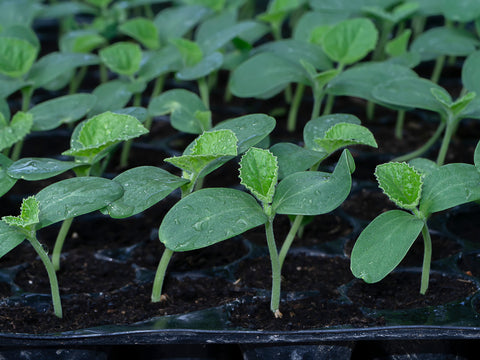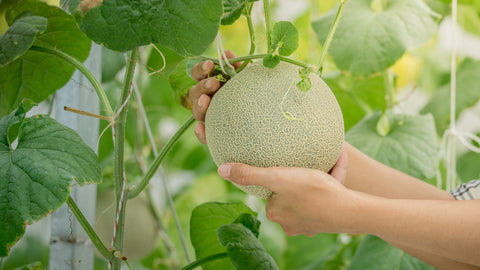Have you ever savored the fresh, sweet taste of a home-grown cantaloupe on a hot summer day? Growing cantaloupes in your garden can be exceptionally rewarding.
Cantaloupes, also known as muskmelons or kharbuja, are warm-season fruits beloved for their lush, sweet flavor. Starting cantaloupe plants from seeds can be a fun and fulfilling project. Before you begin, it’s essential to understand the cantaloupe growing conditions and the importance of using high-quality seeds. Selecting the right type of cantaloupe seeds is the first step towards a bountiful harvest.
This blog will walk you through everything you need to know to successfully grow cantaloupe from seeds to juicy fruit.
• Preparing for Cantaloupe Seeds for Planting
Before you dive into planting melon seeds, a little preparation can go a long way to ensure your plants thrive. Here’s a simple yet effective guide to set the stage for a lush cantaloupe harvest in your garden.
1. Choosing the Right Soil
Cantaloupes require well-draining, nutrient-rich soil to grow. Start by loosening your garden soil up to a depth of about 12 inches and mix in a generous amount of compost or aged manure.
This will not only improve the soil's fertility but also its ability to retain moisture, which is crucial for cantaloupe plants. If your garden soil is heavy clay or too sandy, consider raised beds or containers as an alternative to provide your seeds the best growing conditions.
2. Optimizing the Site
Make sure there is adequate airflow and full sun exposure in the planting area. Temperatures that are warm and sunny are ideal for cantaloupe development and fruit production.
3. Preparing Kharbuja Seeds
To enhance germination rates, soaking the seeds in lukewarm water for 24 hours can help speed up germination by softening the seed coat. After soaking, drain the seeds and pat them dry with a clean cloth. This step is especially useful if you’re planting later in the season or in cooler climates.
4. Testing and Adjusting Soil pH

Cantaloupes thrive in slightly acidic to neutral soil, ideally with a pH of 6.0 to 6.8. Adjust the pH with lime if it's too acidic or sulfur if too alkaline, to ensure your plants can absorb nutrients effectively.
5. Planning Fertilization
Start with a balanced garden fertilizer to support initial growth. As the plants start to flower, address the specific cantaloupe fertilizer requirements by switching to a formulation richer in phosphorus and potassium, which supports robust fruit development.
• The Planting Process

Planting cantaloupe seeds properly is crucial to ensure the best start for your future garden plants. Here's how you can effectively plant seeds in your garden, step by step:
- Whenever planting melon seeds, timing is crucial. Since they need warm soil, plant them after the last frost, when the soil temperature has steadily risen over 65 degrees. This promotes the best possible germination and growth.
- Before planting, make sure your garden soil is loose and rich in organic matter. If you prepared your soil beforehand, lightly rake the surface to loosen it up before making planting holes. This ensures the seeds have good contact with the soil, essential for the cantaloupe to grow effectively.
- Directly sow the seeds into the soil and plant them in rows that are roughly 6 feet apart, 1 inch deep in the ground, and space them about 36 inches apart. This way cantaloupe plants have plenty of space to spread out as they mature.
- After planting the seeds, water the area gently but thoroughly. The soil should be kept moist, but not waterlogged, as this could impair seed germination.
- Once the cantaloupe seedlings emerge and develop a few true leaves, thin them out so that only the strongest plant remains in each group. This reduces competition for nutrients, water, and sunlight, which is critical for the healthy growth of your cantaloupe plant from seed.
• Caring for your Cantaloupe Plants

Did you know that a few simple care steps can significantly boost your cantaloupe's growth and fruit quality? Begin by watering your cantaloupe plants deeply and regularly to encourage strong root development—this is crucial for their overall health and fruit production.
Using organic mulch helps maintain soil moisture and keeps temperatures steady, which is crucial during warmer days. Be vigilant about pests and diseases, early detection and treatment can save your crop.
As the plants start flowering, switch to a phosphorus and potassium-rich fertilizer to enhance fruit development, tailored to cantaloupe fertilizer requirements. Consider supporting sprawling vines with trellises to keep fruits off the ground, reducing disease risks and optimizing garden space. With consistent care, your cantaloupes will grow to be sweet and plentiful.
• Harvesting and Enjoying Your Cantaloupe

Harvesting your cantaloupes at the right time is key to enjoying their fullest flavor. Look for signs like easy detachment from the vine and a change in skin color from green to creamy yellow, which indicates peak ripeness. Once harvested, enjoy your cantaloupes fresh or keep them refrigerated to extend their freshness.
Interested in growing cantaloupes again? Consider saving some seeds from your best fruits, or for more variety and high-quality seeds, check out options like purchasing kharbuja seeds online. Ugaoo offers a diverse range of seeds, making it easy to find the perfect match for your garden conditions and preferences.

















